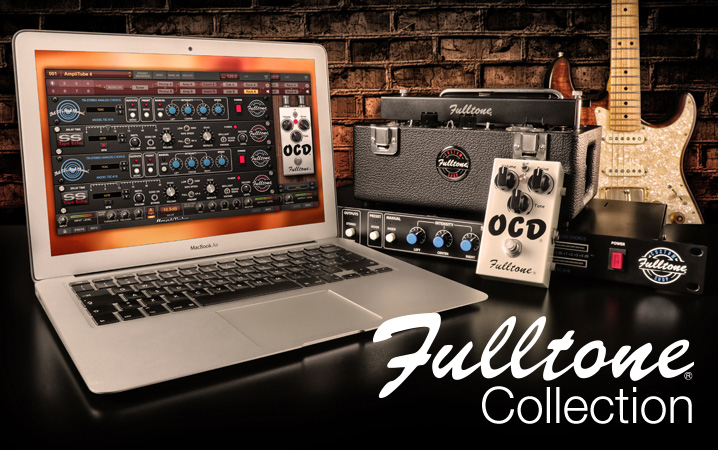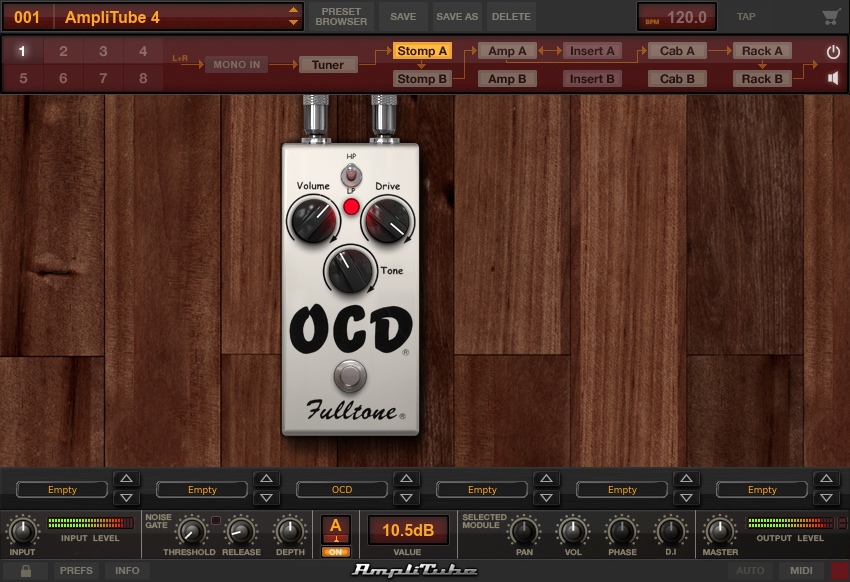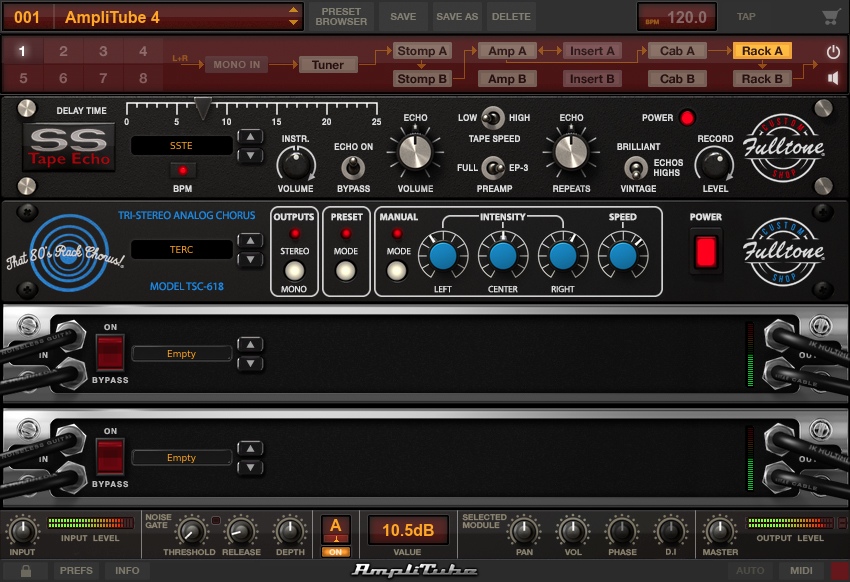New Software Review: Fulltone Collection for AmpliTube by IK Multimedia

IK Multimedia’s Fulltone Collection for AmpliTube features three emulations of unique and popular tools for guitarists: The OCD distortion pedal, SSTE Echoplex and TERC 80’s rack chorus modules.
The Fulltone Collection is a new add-on made for IK Multimedia‘s guitar amp emulation platform, AmpliTube.
Anyone who has used AmpliTube is likely aware that it puts its emphasis on sonic realism in emulating the tone of acclaimed guitar hardware, both classic and recent.
The three components of the Fulltone Collection—the TERC 80’s rack chorus re-creation, the SSTE Echoplex re-creation, and their OCD distortion pedal re-creation—are no exception to this aim to faithfully recreate some of the most useful and sought-after guitar effects.
Features and Use
First, let’s look at the portion of the collection which was already available at the AmpliTube Custom Shop as a one-off purchase: The Fulltone OCD pedal.
The real OCD is a great overdrive stompbox seen on the pedalboards of many, many guitar players, and has become something of a standard of 21st century guitar effects. There’s a good reason why the hardware pedal is such a popular unit: It sounds great and is extremely musical, with a very realistic amp-style overdrive that is capable of sounding authentic and useable, even with nearly no distortion applied (unlike so many other distortion pedals). It also sounds wonderful as a heavily driven distortion, and does great with tones anywhere in between.
The idea of having an emulation of a distortion pedal which emulates the distortion of a guitar amplifier as part of a digital guitar amp emulation seems sort of crazy… but it works. And it sounds awesome. I’m not the biggest fan of distortion pedals, as I only work in the studio and so am more of a fan of just using good amps turned up loud. But for guitarists who gig live though, distortion pedals are a must, and it’s ignorant to think they have no place in the studio as well. In the hands of the right player, they may be able to help deliver certain signature tones that amps just can’t.
The OCD is a very useful flavor of distortion, and in the AmpliTube environment, it adds a great palette of ballsiness, grunge, meat and boost to your tones. Some distortion pedals do one thing really well (if you know how to dial it in), others tend to only work with certain setups and sound awful with others, but the OCD is impressive no matter what its virtual knobs are set to, or what “amp” it precedes.
The knobs available on the OCD are Volume, Drive (amount of distortion), and Tone, as well as the “HP/LP” switch at the top of the pedal. This switch essentially changes the vibe of the distortion; HP (High Peak) having more of a British feel, LP (Low Peak) being more of an old Fender amp-style drive.

An up-close look at the OCD distortion within the AmpliTube GUI—no shortage of parameters available to tweak your tone to perfection.
I can’t say anything bad about the OCD—either the hardware version or this made-for-AmpliTube emulation.
Sure, it doesn’t do every style of distortion ever; there are some distortion pedals which put out a larger variety of tones (and others capable of less for that matter), but it is fairly versatile, and none of what it does sounds bad. I can’t say that about most other distortion pedals.
Put it on an already-driven amp, just to compound to the fury, and it does great. Put it on a clean amp, and kick it in heavy when it comes time for a drastic change to a hard rock or a lead tone, and it kills. Set it mildly and just use it as a slight boost or tone enhancer and the OCD does an excellent job, again.
Moving on to the newer additions to the AmpliTube Fulltone Collection, let’s first examine the SSTE plugin. The SSTE is IK Multimedia’s emulation of their hardware SSTE (Solid State Tape Echo) unit, a modern re-creation and update of the Echoplex EP-3, a classic 1960s tape echo machine built primarily for guitarists.
In this digitized format, the SSTE is an AmpliTube rack-style processor, meaning it can easily be placed in the effect insert or the “rack” (post-amp and cabinet) portion of the chain in AmpliTube. This also means it doesn’t look exactly like the hardware SS Tape Echo, but the controls are all there—including the addition of the “BPM” button for syncing to the tempo of your session, a gigantic feature that neither the original hardware EP-3 nor the Fulltone SS Tape Echo possess.
The SSTE features two choices of preamp emulations: the “Full” (modern, full range sound) or the classic original “EP-3” setting. In EP-3 mode, the SSTE has a more mid-rangey tone and doesn’t quite sound as lush as the Full setting, but certainly sounds cool regardless, and is maybe more likely to find its place cutting through in a mix. The “Echo On/Bypass” switch is a useful tone enhancer, as it lets you use the simulated “electronics” of the unit without having any actual delay effects. Bypassing the echo results in a slightly colored tone and is worth trying.
Another useful feature of the SSTE is the “Record Level” pot, which allows you to dial in tape saturation, thereby distorting the delay repeats. The “Brilliant” and “Vintage” settings essentially offer you bright- or dark-sounding delays, respectively. The “Tape Speed” switch has a similar affect, as it simulates slowing down the tape and therefore cutting the high end of the delays. Last, of course, we have the standard “Delay Time” control (although in this case, true to the original, the SSTE uses a slider, as if to slide the tape playback head to control delay times), an “Echo Repeat” control and “Echo Volume” (the Dry/Wet blend control).
There are some great benefits to the SSTE when used in AmpliTube as opposed to the hardware unit—mainly, not having to deal with any of the hassles of tape. Real Echoplexes are bulky, noisy, and fragile, and if you leave it on all the time, your tape will wear down and your machine will quickly soil itself with magnetic particles on the heads and tape path… not the case in the DAW realm.
Another plus is the sound. This is not your typical delay sound—it is very “tapey” and has a smoother and much different tone than most other delays. What it is not is hi-fi… but it is high-vibe. And as with any digital emulation, you can put multiple instances of the SSTE in your signal path. Using two of these delays serially results in some crazy but totally useable tones, and is way easier than wiring multiple units together, let alone having to purchase and maintain multiple units.
Last but not least, the third component of the AmpliTube Fulltone Collection is the also very analog-sounding TERC module (stands for “That Eighties Rack Chorus”)—AmpliTube’s digital re-creation of the currently-made hardware unit from Fulltone. Fulltone bases their unit off of the very rare Dyno My Piano chorus from the 1980s, which was also sold under the names of Songbird or Dytronics.
The TERC has some interesting controls not found in the average chorusing unit, and perhaps the controls don’t all make sense at first glance… but it sounds awesome regardless.
From IK Multimedia’s website, “Preset Mode, when engaged, creates an evolving, wavy modulation effect that is one of the most popular features of the original unit. The manual mode lets you experiment with different degrees of intensity and modulation for the left, right and central channels, going from subtle to extreme, for a wide open sound that will put a smile on your face.” I would agree.

Navigating AmpliTube’s flexible Plugin Rack is easy and intuitive, sure to allow you to conjure up the perfect tone in no time.
While I have no idea if Prince would have actually used the original unit, the TERC is reminiscent of “that sound”—the “Purple Rain” clean, chorused guitar sound, to give an example. We’ve heard this same vibe on countless other pop ballads from that era as well. The TERC nails that shimmering yet warm, pretty analog chorusing effect, while sounding extremely smooth as a plugin in the digital domain.
In addition to providing these great tools to your AmpliTube setup, the Fulltone Collection also includes some great-sounding presets. Flipping through, I found them all to sound very nice, many of which were fairly complex in setup, yet quick and easy for the end user. Whether you choose to make regular use of the Fulltone Collection presets or not, they are worth trying, as they do a good job of showcasing the various capabilities of each device, and can also inspire guitar tones that you might not have created on your own.
Summing it Up
Every aspect of each unit within the Fulltone Collection sounds great, is musical, and is generally easy to figure out. To top it off, the price is beyond fair. The Fulltone Collection sells for $47.99 at the IK Multimedia online store. In my opinion, that price point for just the SSTE delay portion of the bundle would be a steal. Available for use with both AmpliTube 3 and AmpliTube 4 (on Mac or PC), we have another great product from the developers at IK Multimedia.
Please note: When you buy products through links on this page, we may earn an affiliate commission.






